 |
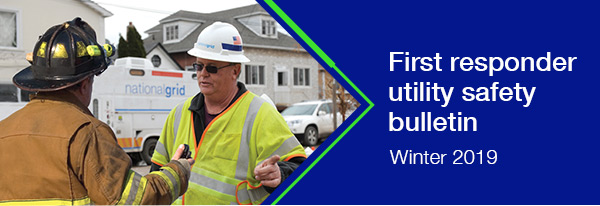 |
|
Natural gas odor or residential methane detector activation in a structure: Your key response strategies
|
|
Responding to the report of a gas odor or the activation of a residential methane detector (RMD) requires vigilance. Natural gas detection and mitigation operations place first responders in direct proximity to an IDLH (immediately dangerous to life and health) environment that may become explosive if the concentration of natural gas enters the flammable range.
|
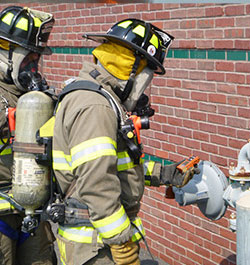 |
|
|
Natural gas consists primarily of methane. Gas is odorized with Mercaptan, which gives it a distinctive, sulfur-like smell. Your nose can detect the odor of a natural gas leak, while an RMD reacts to the actual presence of methane. In either situation, it is essential that you utilize a combustible gas indicator (CGI) to confirm the presence and concentration of natural gas. Given the relative risk associated with a gas leak, consider any gas odor report or RMD activation to be credible until CGI monitoring proves otherwise or National Grid personnel report the structure is safe.
|
| |
|
|
|
When responding to a report of a natural gas odor, remember that National Grid personnel are the experts in natural gas detection and control. As soon as a potential natural gas leak is reported, your dispatch center should request the response of National Grid.
|
| The following are basic tips for responding to the odor of natural gas or RMD activation. For comprehensive natural gas leak response guidance, please visit the National Grid Utility Safety Website: firstresponder.ngridsafety.com. |
|
|
| Upon arrival |
| 1. |
|
Approach the incident scene cautiously. Park at least 100 feet from the front of the building and away from manhole covers, gas valve covers and storm sewer grates. |
| 2. |
|
Meet with the reporting party at least 100 feet away and upwind from the structure to obtain information about the location of the odor or RMD detector that is sounding and the location of the gas meter and gas-fed appliances. |
| 3. |
|
Communicate the status of the natural gas service to both operating crews and your dispatch center. |
| 4. |
|
Clear the building of all occupants and bystanders. Do not enter the building unless you are wearing full personal protective equipment (PPE) and self-contained breathing apparatus (SCBA). |
| 5. |
|
Eliminate any potential sources of ignition, such as vehicle engines, flame-producing devices and anything that could produce sparks. Use intrinsically safe radios and flashlights. Do not ring doorbells or turn on or off any electrical switches, as a spark from these devices could ignite the gas. Do not step on doormats; friction from your boots could create a spark of static electricity. |
| 6. |
|
Use a CGI to monitor the atmosphere in and around the structure. If gas concentrations are well below the lower explosive limit of 5 percent gas in air and you can enter the structure without risk, monitor inside the building to find the source of the leak. If gas concentrations are within or above the flammable range (between 5 and 15 percent gas in air), secure and clear the area and develop an operational plan to mitigate the situation with National Grid personnel. |
|
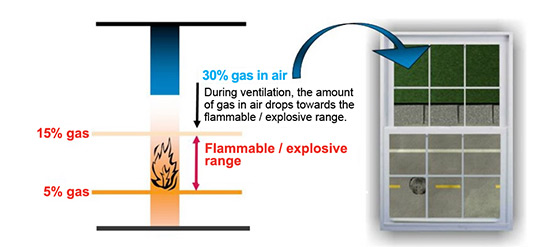 |
If a high concentration of gas is present, it may fall
into the explosive range as a structure is ventilated. |
|
| If a leak is confirmed |
| 1. |
|
Reposition and stage apparatus upwind and out of the collapse zone of involved structures, at a distance of 330 feet. Secure the structure and isolate the leak area for at least 330 feet in all directions. |
|
| 2. |
|
Utilize DOT Emergency Response Guide 115 and work with National Grid personnel to obtain situational guidance and coordinate the safe control of the situation. |
|
| 3. |
|
Control an indoor natural gas leak by turning off gas at the service valve before the meter, provided you have been trained to do so. Follow your department’s guidelines with respect to operating gas service valves. |
|
| ○ |
|
After the service valve has been closed, do not open it under any circumstances. Only utility representatives can restore gas service. |
| ○ |
|
Inform National Grid of any service valve you have closed and its precise location. |
|
| |
|
|
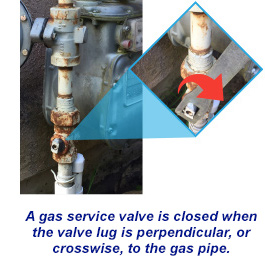 |
|
| 4. |
|
Have a charged hand line with a fog nozzle ready to use in the event of a fire. This line should be utilized to cool exposures and limit fire spread. Once a gas fire is ignited, it should not be extinguished until the source is controlled. |
|
| 5. |
|
If ventilation is indicated, it must be coordinated by National Grid personnel in conjunction with your incident commander (IC). When it has been determined that ventilation is safe, ventilate the building from the top down, using natural air currents. Remember: If a high concentration of gas is present, it may fall into the explosive range as a structure is ventilated. |
|
| 6. |
|
Coordinate with National Grid personnel to restore service. |
|
|
|
| Case in point: |
| Complacency during gas odor investigation results in multiple firefighter injuries |
In May of 2018, a report of a natural gas odor was received in a rural Maryland fire district. The first engine arrived on scene to find a very strong odor of natural gas. The arriving crew utilized their 4-gas meter and CGI and began an investigation that led them to a door where the odor was strongest.
Considering the potential risks associated with a gas leak, response operations should always include the use of full PPE and SCBA. Yet several in this crew conducted their investigation with no SCBA. One of the members walked to the back of the structure, encountered a strong odor of Mercaptan and was immediately overcome. This firefighter crawled to safety; another two crewmembers were affected but able to walk from the area. The exposed firefighters were given oxygen, decontaminated and taken to the hospital, where they were treated and released later that day.
|
|
|
| Learn more gas and electrical utility response tips at firstresponder.ngridsafety.com. |
|
National Grid’s free First Responder Utility Safety Training Program has helped thousands of emergency response personnel learn to operate safely during incidents involving utility hazards. This program, which includes gas and electric certification trainings, covers natural gas pipelines and electric power lines as well as other facilities.
|
| |
|
|
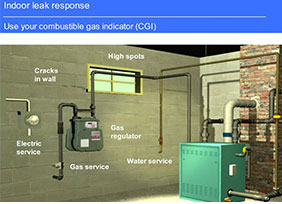 |
|
|
Through this training, you will gain the knowledge, skills and technical ability required to respond to the most common electrical and natural gas emergencies.
|
|
Our certification programs are self-paced. Users who complete the gas and electric programs will earn personalized certificates of completion.
|
|
|
| Keep yourself, your team and the public safe. Visit firstresponder.ngridsafety.com today to register and complete your utility safety training. |
|
|
| To report emergencies, call 911 and National Grid immediately. |
|
| In case of gas emergencies: |
| Long Island and the Rockaways: |
|
|
|
|
|
|
|
|
|
|
|
| In case of electric emergencies: |
| Upstate New York: |
|
|
|
|
|
|
|
|
|
|
|
|
 |
| #11514 |
|
|